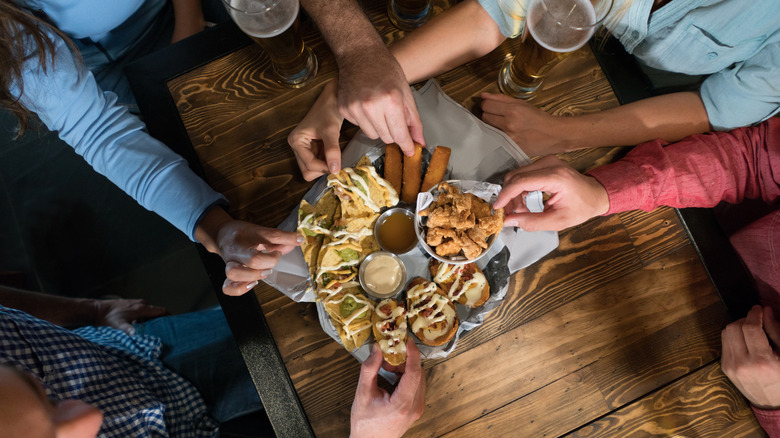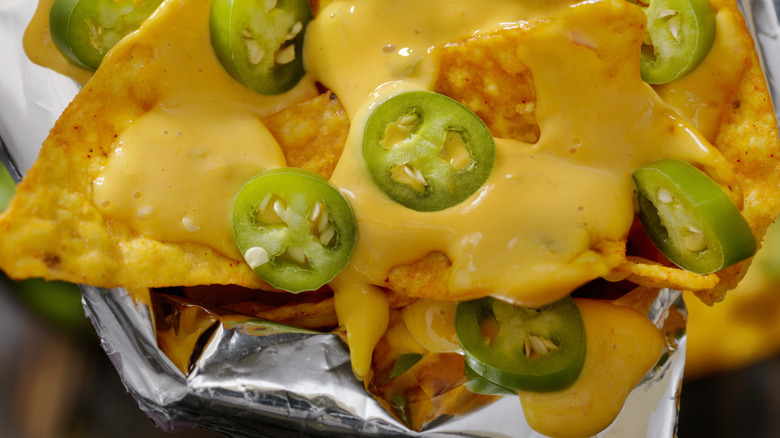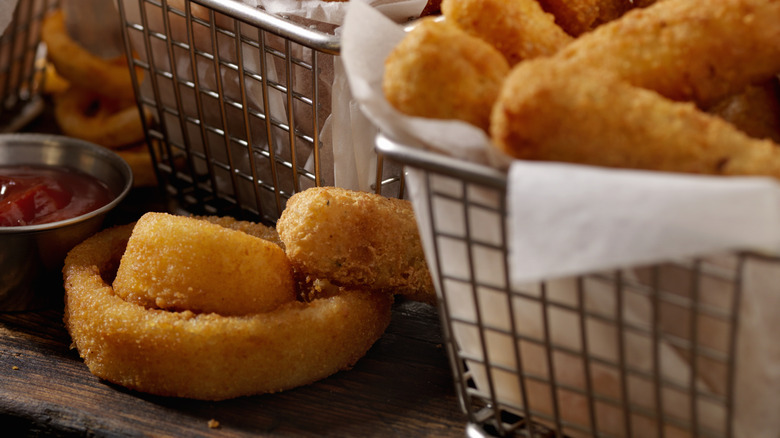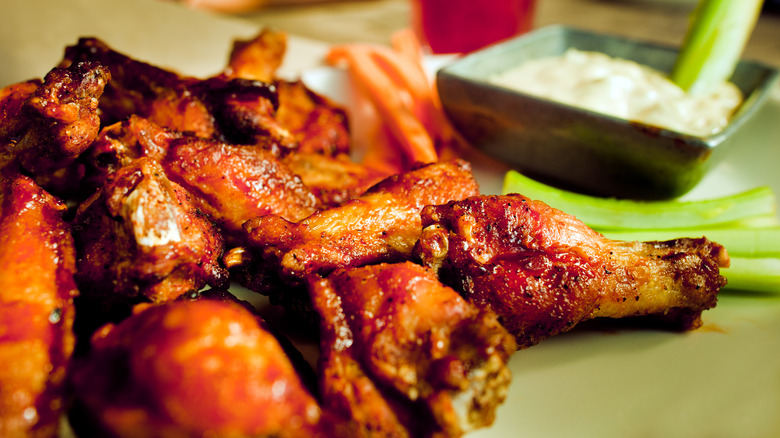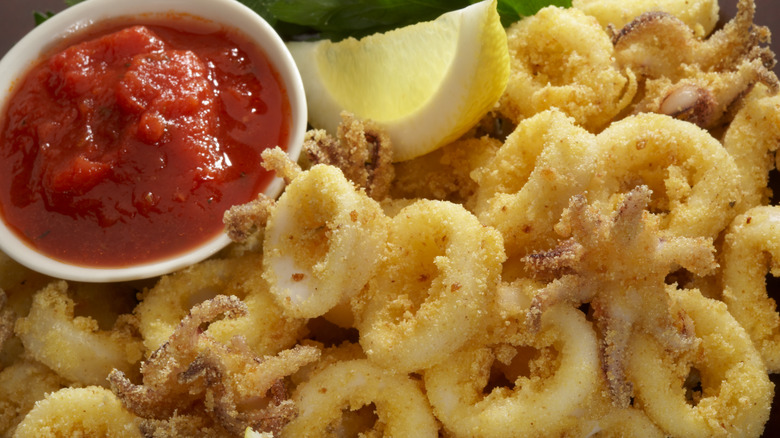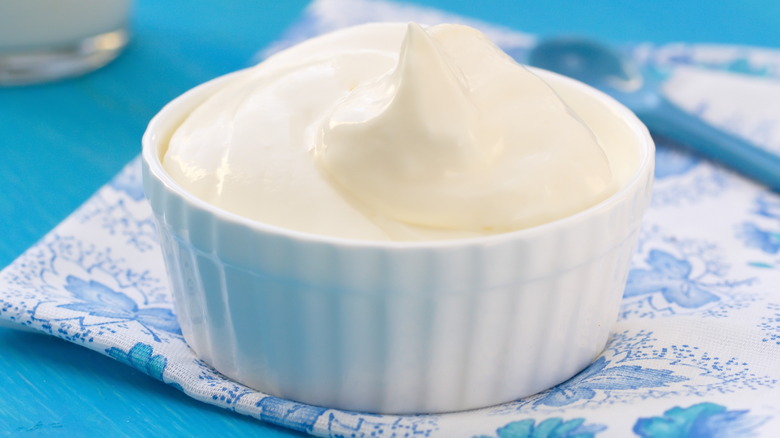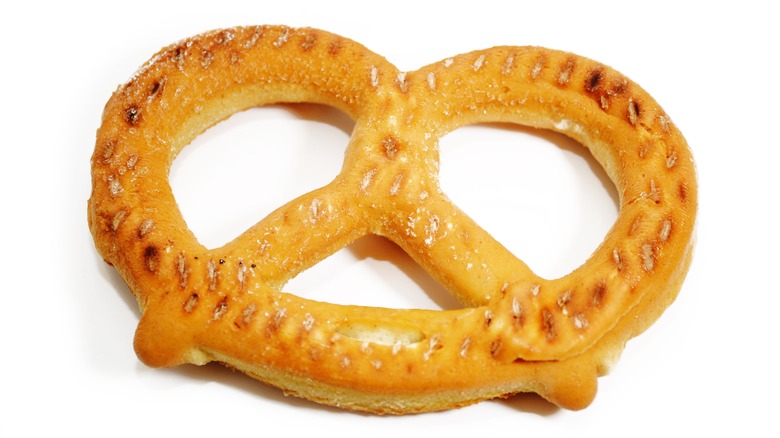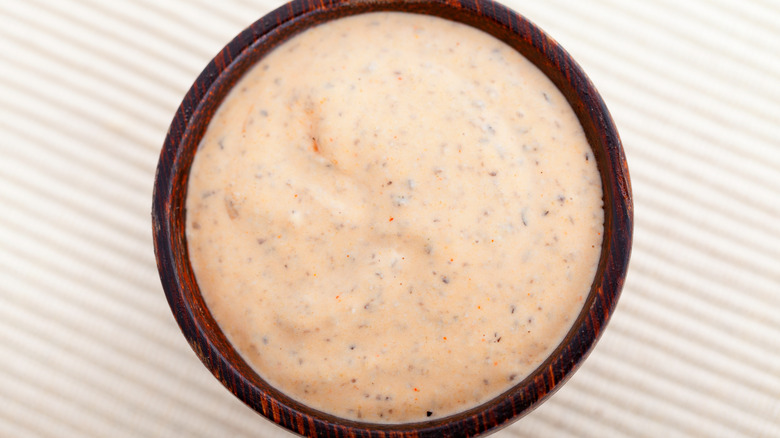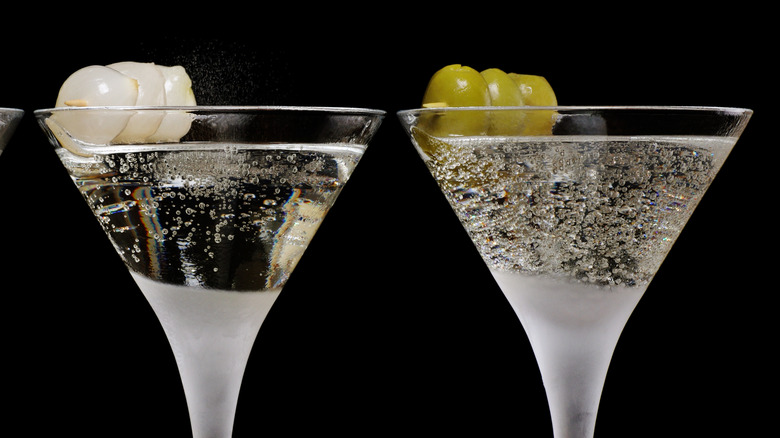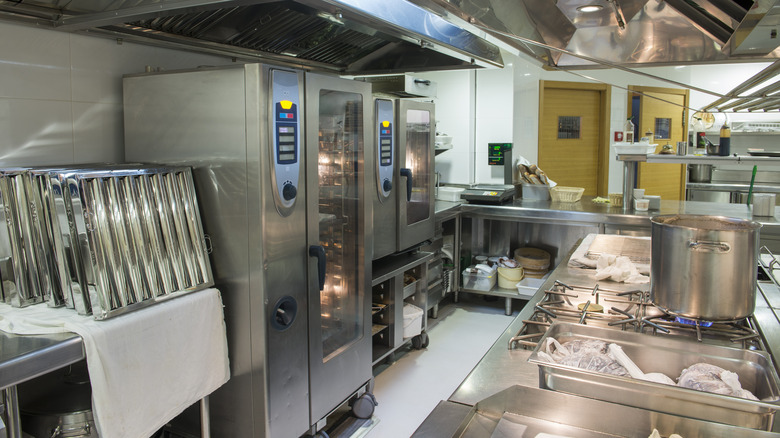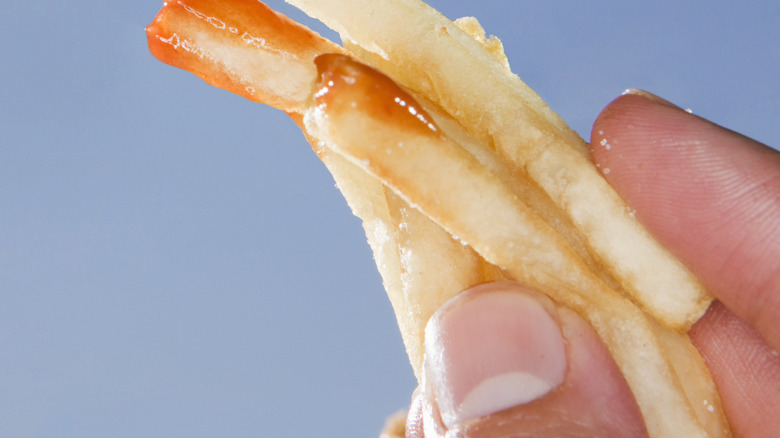12 Worst Foods To Order At A Bar, According To An Expert
Many bars serve food, but it isn't (normally) the main priority. In fact, it's often seen as a way to keep drinkers hanging out for longer, and not much else. Because of this, the food offered at many bars won't wow you. Even if you know this about bar food and expect it to be mediocre, there are a few foods you might want to think twice about ordering (ahem, regardless of how drunk you are). From low-quality frozen foods to unreliable preparation to an increased potential for germs and bacteria, several bar foods are best left on the menu.
I have 20 years of food service industry experience, and many places I worked were bars. During my time in the industry, I learned quite a bit about how things go down in the kitchen, including the quality of foods and how they are prepared. I recalled personal experiences and conversations with other food service workers to create a list of the 12 worst foods to order at a bar.
Of course, not all bars have the same issues, and many places serve delicious food. Still, I'll tell you about a few common practices and food standards that might just change how you order moving forward. Keep reading to learn about what my experience has shown me so you can avoid certain foods, or, at the very least, make an educated decision and order like a pro.
Cheese sauce
Cheese sauce is an ingredient that you almost certainly want to avoid ordering at bars. It comes on familiar favorites like nachos and chili cheese fries, which sound delicious. Still, skip it, unless the menu specifically says the kitchen uses a homemade cheese sauce or shredded cheese. The cheese sauce used won't be anywhere close to a classic chile con queso. Instead, many bar kitchens use a cheese sauce that comes in a humongous can and the quality is abysmal. Seriously, it's as bad as 7-11 or ballpark nacho cheese sauce quality. I'm not talking about the good stuff they serve on the club level, either.
If you accidentally wind up with some of this dreaded cheese sauce in front of you, the first thing you notice is the severe lack of flavor. It also has an alarming orange-yellow hue and a texture somewhat like plastic — yuck! Every time I saw a cook open a new can of this cheese sauce and pour it into a pan I couldn't believe how unappealing and artificial it looked. To top things off, the same sauce is often reheated for many days, making it even more congealed and less appetizing (not that it ever looked appetizing in the first place).
Breaded and fried foods
I know that breaded and fried foods are a favorite of drinkers, and often, bar menus consist mainly of breaded fried foods. Still, they shouldn't be your first, or even second pick if you are looking to munch on something tasty and at least mid-grade quality-wise.
While people gobble up breaded fried foods with fervor after a night of drinking, they are guaranteed to be lacking the flavor and texture you really want. There's a simple explanation for this: They are frozen. Bar kitchens get extremely busy, and they don't have time to prepare freshly breaded ingredients. As a result, they serve frozen foods that can easily and quickly be heated for serving, but they are often bland and generic. My least favorite breaded fried option to serve was mozzarella sticks. They were hard and bland, and some barely even had cheese inside.
Unfortunately, breaded fried foods encompass quite a lot of options on a typical bar menu. In addition to mozzarella sticks, you should expect fried fish, jalapeño poppers, chicken tenders, onion rings and more to be frozen. For many, this may not be a deal breaker. However, it's one thing to buy these foods for your home and another to pay premium prices for something you could easily pick up at the grocery store. Of course, I wouldn't blame you if you chose to order them anyway after a few drinks — as long as you know what to expect, you won't be let down.
$1 wings
Chicken wings are an American favorite. You find them served at most bars, especially sports bars, and people love them. They come smothered in an array of tasty sauces like buffalo and BBQ, and you get to dip them in ranch or blue cheese dressing. In addition, they often go on special for $1, making them highly appealing. With all this in mind, it's no surprise people order chicken wings like crazy at bars, but there are a few reasons you should think twice about partaking.
To facilitate a $1 chicken wing special, bars use extremely low-quality, frozen wings. At several bars I worked at, the wings were small, tough, and didn't have a lot of meat. The sauces were also sub-par. People complained about them, but there wasn't much that could be done considering the ingredients.
To make matters worse, at the bars where I worked the wings were fried in advance and they sat around for a while before an order came in. Then, they were fried again and served. While this preparation technique helps save the kitchen time, it depends on rapid orders to ensure food safety. According to the FDA, leaving cooked wings at room temperature for more than two hours can be dangerous and lead to sickness. I'm not trying to be dramatic, but unless a bar is busy, you can't be 100% certain the wings haven't been sitting out for too long. If you're unsure, play it safe and order something else.
Calamari
Calamari is a pretty common menu option at bars. It is great for sharing and people don't typically make it at home, so it sells quite well. Don't let this fool you, though. Bars aren't known for serving the freshest seafood unless, of course, you're at a coastal bar with excellent food. In general, bars serve frozen seafood that isn't considered fresh by any standards, and this includes the calamari.
In addition to being frozen (something land-locked people expect more than others), bar calamari is generally poor quality, rubbery, and bland. Sure, it's often deep-fried and comes with a dipping sauce, but even that won't disguise the apparent lack of flavor and obnoxiously chewy texture. It's best to leave it in the kitchen and order something else.
The HuffPost also reported on an urban legend about the potential for imitation calamari and it being made from pig rectum. While there are no actual known cases of this happening, it's enough to make me think twice about ordering calamari from most places, particularly bars or anywhere that doesn't pride itself on serving fresh seafood.
Sour cream
If you've ever wondered how long sour cream stays fresh after opening, you're not alone, and the answer may surprise you. According to the U.S. Department of Agriculture, sour cream lasts for approximately one to three weeks. Of course, it needs to be stored in the fridge, but that's a pretty long time. Even so, I'd be skeptical about ordering it from many bars.
Sour cream may not spoil as fast as other dairy products, but I can't truly say a bar kitchen keeps sour cream at ideal temperatures all of the time without error. Tubs of sour cream are kept on the line, and while there may be chilled compartments, the temperature fluctuates continuously. It is also a pretty hot environment overall, sometimes unbearably so. Even with the best intentions, sour cream can easily turn bad much faster when kept under these conditions. Unfortunately, it is also difficult to tell when sour cream has turned if you only get a small ramekin or dollop on a dish you ordered because it always smells a little sour.
Soft pretzels
Soft pretzels and sporting events go hand in hand, so many sports bars include them on their menus. Ordering one while you catch a game on the big screen may sound nostalgic and appetizing, but I recommend against it. Not only are soft pretzels served at bars (previously) frozen, but they are dry, hard, and, in my opinion, taste more like cardboard than a pretzel. Depending on the sauces a bar serves alongside its soft pretzels, you may be able to choke down a few bites but don't expect to be blown away. Actually, I've never worked somewhere where I would recommend soft pretzels. I usually advised my customers against ordering them for the reasons listed above.
If seeing soft pretzels on a menu and not ordering them leaves you with a craving, try making them at home instead and you'll be glad you did. An authentic from-scratch recipe can be a bit involved, but there are some ways to work around this. For example, you could try out a store-bought shortcut for homemade soft pretzels that involves making them with pizza dough. While they won't be quite the same, they'll be pretty tasty and will certainly quench a craving.
Salad dressing
You probably are not going to like this, but salad dressings are another thing I tend to stay away from at places with low-quality bar food. Sure, if I've been drinking I may not be able to resist a little ranch for dipping, but I definitely wouldn't go out of my way to order several different kinds of dressing. My reasoning? Most bars don't make their salad dressings in-house, they use the mass-produced stuff and it isn't kept in the best conditions.
Let me start by saying, there isn't anything wrong with pre-made salad dressings. In fact, most of us have several jars of them in our fridges right now. However, the ones used in commercial kitchens come in massive plastic jugs. I'm not sure of the exact size, but about two gallons per container seems right. Again, this could be just fine, but it gets poured out of these jugs into another container many times. After several repetitions, a thin, crusty layer starts to form along the lip of the jug and drip down the sides. It slowly congeals and not only looks gross but all the dressing poured out of the container in the future passes over and touches the congealed mess. I can't count how many times I've seen massive salad dressing jugs in bar kitchens that looked like this and it always made me feel somewhat uneasy. Proceed with caution if a bar doesn't proudly state that it makes its salad dressings in-house.
Pearl onions and olives
If you are at a nicer bar, it might be normal to order a martini. However, they are rarely ordered at dive bars. Because of their infrequent consumption, the jars of olives and onions kept behind the bar for the occasional customer are unlikely to be very good. Chances are also really good they have been around for an exceptionally long time. For example, in one of the bars where I was employed, we had the same jar of onions in the fridge the entire time I worked there, which was years. If that isn't enough to make you reconsider, what is?
In the same establishment, we used more olives than pearl onions, but they were still questionable. The olives were poured out of the large jar into a smaller container for placement in fruit trays. During their time there, they were exposed to all kinds of things, like people grabbing them with hands that just touched money and random people helping themselves to them.
Bars are supposed to use tongs to pick up garnish fruit for drinks, but this practice often falls by the wayside when it gets super busy. I worked in several places that didn't even have tongs to keep up appearances. So, even if a bartender says they can make a martini with olives or pearl onions, you may want to skip them and opt for a lemon twist instead.
Bar snacks
There are lots of bars that don't have full kitchens and instead, place little bowls of trail mix or spiced nuts on the bar to give patrons something to munch on while they imbibe. Or, maybe they sell pickled eggs or have a popcorn machine. Some bars with kitchens provide snacks like this too, but either way, it is best to steer clear of them. Pickled eggs are rarely ordered, so who knows how long they've been marinating, and when it comes to the bowls of nuts, just don't. Everyone sticks their hands in them and your guess is as good as mine as to when they last washed their hands. The potential for bacteria and germs is simply too high for my liking.
I worked at a sports bar that had a self-serve popcorn machine and if you saw how people behaved when getting a bag, you'd be appalled. Many people got popcorn from the machine with the provided scoop, but plenty of people used their hands. I also witnessed people spill their drinks inside the machine and, one time, I even saw someone, uh, "lose their lunch" in the popcorn chamber. It was cleaned, of course, but things went on like normal afterward. I for one certainly never thought about eating popcorn out of it again. Consider yourself warned.
Hot dogs
Hot dogs are another classic American food synonymous with sporting events, so many sports bars feature them on their menus. This can be great for kids, but kids aren't the typical clientele for bars, so not many people order them. As a general rule of thumb, it is best to avoid foods that may have been in the kitchen for an extended period before being served. They very well could be fine, but they certainly aren't going to be one of the best options on the menu; they'll be one of the worst.
Hot dogs served at bars are almost always going to be low quality. Don't expect an all-beef hot dog by any means. Instead, what you're likely to get is a mixed hot dog that looks and tastes cheap. Plus, most bars are unlikely to have many toppings aside from mustard and ketchup. They might not even have relish. Do yourself a favor and get something a little more reliable. There's a time and place for a great hot dog, and unfortunately, a bar usually isn't one of them.
Just about everything if you practice a plant-based or gluten-free diet
Many professional kitchens are more than equipped to handle dietary restrictions and preferences like gluten intolerances and plant-based dietary needs. However, lower-end bars don't typically fall into this category and while there are lots of ways to prevent cross-contamination, it happens quickly. One example of this is on the flat top, where burgers, sandwiches, and more are prepared. If you're gluten-free, bread might be cooked alongside your food, making contamination likely. The same goes for vegetarian burgers and sandwiches but with meat contamination. Deep fryers are also notorious for cross-contamination because all different kinds of foods are put into the same oil, whether vegetarian, gluten-free, or not.
If you have a serious allergy or are extremely strict about your diet, the safest bet is to avoid most bar menu foods. Salads and a select few other items might be safe, but considering the fast-paced environment of bar kitchens, mistakes are bound to happen and you are unlikely to know about them until it is too late.
If you decide to risk it and order food from a dive bar, make sure to tell your server or bartender about your dietary preferences so they can steer you in the right direction and alert the kitchen to your needs. In many bars, the cooks can take special precautions to prevent unwanted cross-contamination, like cooking your food in a separate dish and using specific utensils. Even so, this doesn't guarantee anything.
French fries
Alright, you're not going to like this, but french fries aren't always a safe bet at bars, either. Admittedly, there are plenty of bars that nail their french fries and even make them in-house, but there are also lots of bars that don't. Bars in the latter category serve mass-produced frozen fries. Sure, they are cooked in a deep fryer, leading to tastier results than you get by just baking them, but they still aren't considered exceptional.
If you can overlook french fries being frozen, which many of us can, you still have to worry about how they are prepared in busy bar kitchens. I worked in a bar that fried large batches of fries and kept them in a metal bowl under the heat lamps. When an order came in, a portion of fries was taken out of the bowl and fried again, leading to an overcooked, hard texture. In addition, while the bowl sat under the heat lamps, employees passing by would frequently stick their hands in the bowl and grab a couple of fries as a snack. We even got fined by the health department once because an inspector witnessed someone doing it.
Don't let this scare you too much, though. Lots of bars serve french fries that are prepared correctly and are at the very least, edible. Proceed with caution, and manage your expectations.

